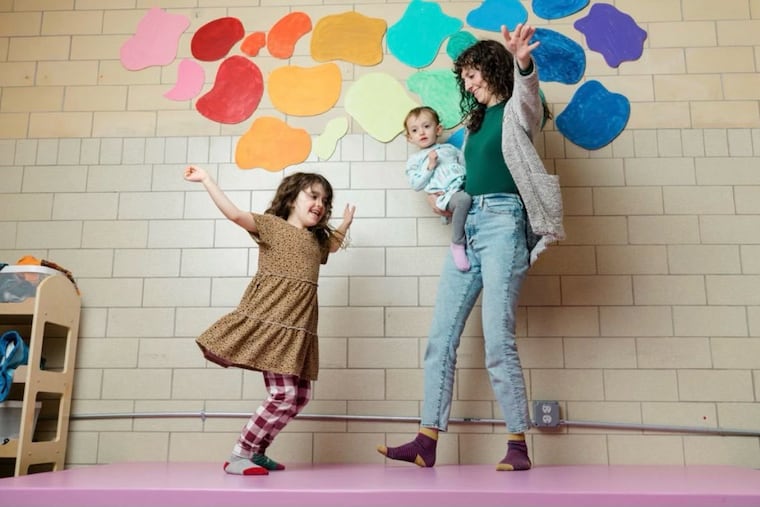What do you call a sleepover that ends before the next morning? A sleep-under.
Kids do everything they would at a standard sleep-over, but return home with their parents later in the evening.

Madeline Daulerio, all of 6, has made an important lifestyle decision: She won’t do sleepovers, but she’s always up for a sleep-under.
“I like to bake cookies, do arts and crafts, watch movies” and participate in the usual sleepover activities, the South Philadelphia youngster said. But sleeping in someone else’s house “feels scary. I’m used to sleeping in my own bed.”
The sleep-under is becoming popular with young children and their parents who, for one reason or another, aren’t into the full-night commitment of what for decades has been a treasured kids’ tradition. At these events, children do everything they would do at a standard sleepover, but return home with their parents later in the evening.
For many parents, sleep-unders are a practical alternative to the sleepover. They provide children with an exciting night with friends, without producing the whiny fatigue of the sleepover’s dreaded morning after.
For some moms and dads, sleep-unders ease fears of possible sexual assault and abuse in someone else’s house, or worries about the presence of guns in others’ homes, or of simply not knowing the parents hosting overnights, child psychologists say.
Rachel Daulerio, Madeline’s mom, sees the sleep-under as the best way to deal with her child’s concern about staying all night in a strange house.
“I’d worry that she’d be sleeping at a friend’s and I’d get a 2 a.m. call that she’s nervous and uncomfortable,” said Daulerio, 38, a first- and second-grade teacher at the Philadelphia School, and co-owner of Beehive at Bok, an indoor play space in South Philadelphia.
“Kids can get excited about the idea of a sleepover beforehand, but it can become scary to them once it’s happening.”
Daulerio has hosted a few sleep-unders that have garnered her high marks among neighborhood kids. Typically, her daughter’s friends arrive in their pajamas, do each others’ nails, decorate and bake cookies, then move on to pizza and Harry Potter movies.
“And by 9 or 9:30,” Daulerio said, “everyone goes home and we all get a good night’s sleep.”
Andrea Eckert, 46, of Chestnut Hill, said sleep-unders are nothing new.
“We didn’t call them sleep-unders years ago,” said Eckert, who does development work for a nonprofit, “but we gave the kids the novelty of staying up later than normal. And we made things more convenient for their parents by having them pick the kids up before we all went to bed.”
Nowadays, Eckert’s 12-year-old son, who enjoyed sleep-unders around five years ago, tells her that he wants to reprise them with friends at a buddy’s house.
“Yeah, he’s calling it a sleep-under,” Eckert said, “but what he’s really asking is for a later curfew, till midnight.”
Joannie Yeh, 41, a professor of pediatrics at the Sidney Kimmel Medical College at Thomas Jefferson University, said she “absolutely” prefers sleep-unders: “I’m not a fan of sleepovers for my children.” Her three kids — ages 4, 8, and 11 — aren’t allowed to attend any.
“Look,” Yeh explained, “abuse of children is something I see as a pediatrician, and it worries me for my own children. And always telling them no sleepovers is one less decision I have to make.”
She added that she has “zero judgment” of parents whose kids have sleepovers. “But,” Yeh said, “when patients’ parents ask me about sleep-unders, I say it’s a really great alternative. Parents can feel more comfortable, and kids can still socialize.”
The opportunity to gather with friends is important for development whether kids are sleeping under or over, noted Leah Orchinik, pediatric psychologist at Nemours Children’s Health, Delaware Valley, in Wilmington.
She added that she doesn’t want to make parents think that sleepovers themselves are problematic.
“Many successful adults have had sleepovers,” she said. “And, if the kids are ready for it, there’s value in waking up in someone else’s home — to see how others live, to have a breakfast that might be different than the one you’re used to, to learn how to adapt.”
Orchinik said that it’s smart for parents to be cautious about where their kids sleep, within reason: “Let’s not discount real safety concerns, but let’s not be overprotective and shield kids from safe and reasonable situations.”
Some parents are more comfortable with hybrid sleeping parties.
Julia MacMullan, 39, of Ambler, the director of marketing for Springside Chestnut Hill Academy, said she and her friends have participated in sleepovers in which the parents stay with their kids.
At a Chestnut Hill backyard campout sleepover not long ago, MacMullan and her daughter, Ellie, 6, slept in the same tent.
“It was hilarious,” MacMullan said. “And even though my daughter wound up crawling into my sleeping bag at 2 a.m. and squashing me, all the parents admitted it was a great time.
“The main thing is the kids had fun.”